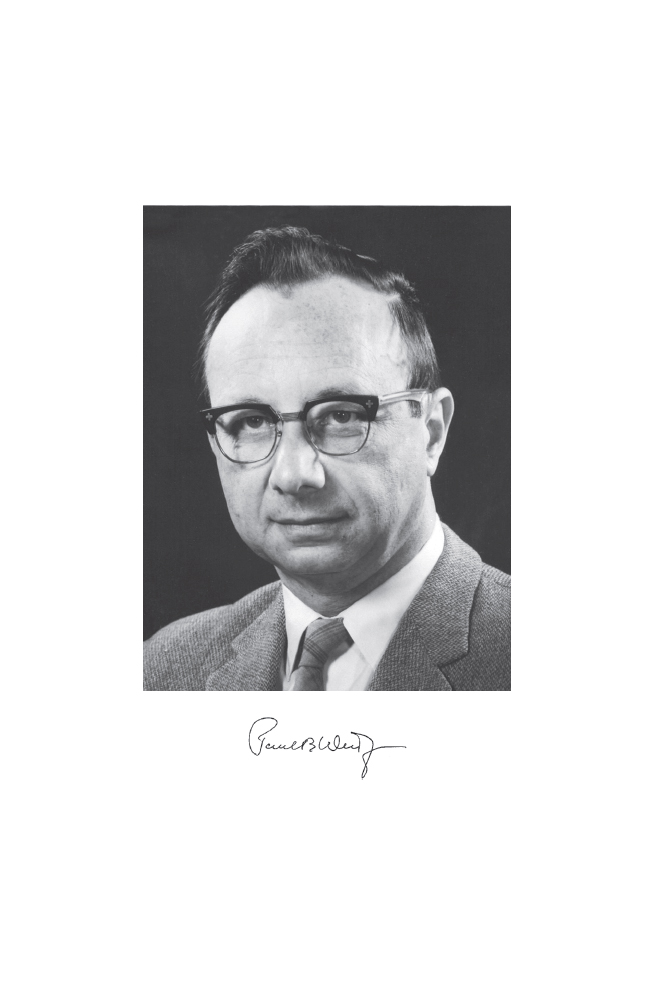
1919–2012
Elected in 1977
“Contributions in pioneering the use of molecular sieves as cracking catalysts for petroleum hydrocarbons.”
PAUL BURG WEISZ, an internationally recognized expert in petroleum refining catalysts, died on September 25, 2012, in State College, Pennsylvania, at the age of 93. His work at Mobil Oil, with collaborators including Nai-Yuen (N.Y.) Chen, Vince Frilette, John McCullough, Dwight Prater, Jack Wise, Al Schwartz, Heinz Heineman, and Fritz Smith, helped lay the foundations for zeolite catalysis. His seminal work in the use of natural zeolites as highly shape-selective conversion catalysts set the stage for 50-plus years of highly productive process research and revolutionized the refining and petrochemical industries.
Born in Pilsen, Czechoslovakia, on July 2, 1919, to Alexander and Amalia Weisz, Paul grew up with an innate desire to become a scientist and published his first article in a ham radio journal at the age of 16. He emigrated to the United States from Berlin in 1939, interrupting his graduate studies in pre–World War II Germany to attend Auburn University, where he completed his BS degree in less than a year. After graduation he worked as a researcher at the Bartol Research Foundation of the Franklin Institute in Swarthmore, PA. He
___________________
Editor’s note: This tribute was slightly adapted from the obituary published by the North American Catalysis Society, of which the author is a trustee.
later moved to the Massachusetts Institute of Technology where, as an electronics engineer, he participated in the development of LORAN, a long-range radio signal–based aid to navigation.
He joined Mobil Research and Development Corporation in 1946 as a research associate at the company’s research laboratory in Paulsboro, New Jersey. He progressed through a number of technical assignments to reach the position of senior scientist, the highest technical position in Mobil, in 1961. He managed the company’s Exploratory Process Research organization in 1967–1969 and then its Central Research Laboratory in Princeton through 1982. He retired in 1984.
Shortly after joining Mobil, Paul turned his attention to diffusion and catalysis, the foundation of a lifelong interest in porous materials as catalysts and specifically in crystalline hydrous aluminosilicates known as zeolites. Along with several Mobil collaborators, he pioneered the use of natural and synthetic zeolites as catalysts for petroleum refining and petrochemical manufacture. These zeolite catalysts eventually revolutionized many refining processes because they facilitated only certain reactions between molecules of specific dimensions.
In 1960 Paul published a ground-breaking paper, coauthored with Vince Frilette, another Mobil scientist, that became the foundation of “shape-selective catalysis” and one of his most widely cited papers (“Intracrystalline and Molecular-Shape-Selective Catalysis by Zeolite Salts,” Journal of Physical Chemistry 64(3):382). Processes based on Paul’s concept of shape-selective catalysis were first commercialized in the early 1960s, and throughout the 1970s and 1980s he was closely associated with Mobil’s development of new catalytic materials and the processes that were developed around them.
While working at Mobil, Paul took a sabbatical in 1964 to earn his doctoral degree from the Eidgenössische Technische Hochschule (ETH) in Zurich in 1966. His thesis presented an analysis of the permeation of dyes into fibers that was the foundation for some of the fundamental laws associated with diffusion of dye molecules into fibers.
One of Paul’s formidable strengths was his ability to communicate complex theories succinctly. He was a constant contributor to the ACS publication ChemTech throughout the 1970s and 1980s, enlightening and delighting readers with his insightful observations of how phenomena such as diffusion and kinetics applied to everyday life.
His 1962 article with J.S. Hicks, “The Behavior of Porous Catalyst Particles in View of Internal Mass and Heat Diffusion Effects” (Chemical Engineering Science 17(12):265–275), was selected as one of the 50 most influential articles in Chemical Engineering Science in the publication’s 1995 Frontiers in Chemical Engineering Science commemorative edition (50(24): 3849–4141). His 91 US patents and more than 180 journal publications cover topics ranging from carbonaceous deposits on catalysts to chemical agents that affect the diffusion of drugs in human cells.
After he retired from Mobil in 1984, he began a third highly productive career, applying chemical and physical principles to biomedical research first at the University of Pennsylvania and then at Pennsylvania State University. Working with Madeleine Jouille at the University of Pennsylvania he synthesized molecules that mimic some of the healing properties of heparin but do not exhibit its potentially dangerous side effects.
His numerous industrial research accomplishments and contributions to the science of catalysis were well recognized over the years: he was selected for the E.V. Murphree Award in Industrial Chemistry from the American Chemical Society (ACS; 1972), the Chemical Pioneer Award from the American Institute of Chemists (1974), the ACS Leo Friend Award (1977), the R.H. Wilhelm Award in Chemical Reaction Engineering from the American Institute of Chemical Engineers (1978), the Lavoisier Medal from the Société Chimique de France (1983), the ACS Langmuir Distinguished Lecturer Award (1983), the Perkin Medal from the American Section of the Society of Chemical Industry (1985), the ACS Carothers Award (1987), and the National Medal of Technology from President George H.W. Bush in 1992. He was elected to the National Academy of
Engineering in 1977 and served on the NAE Panel on Future Directions in Fundamental Research Related to Fossil Energy (1987) and Panel on Energy and Natural Resources Processing (1985–1988). He received an honorary doctorate (ScD in technological science) from ETH in 1980.
Paul Weisz leaves behind a very rich scientific and technical legacy that has greatly impacted the academic and industrial catalysis research communities. His work continues to inspire chemists and chemical engineers working in the area of catalysis and biomaterials.
His family remembers Paul enjoying many hours contacting other amateur radio operators. In addition, he was an excellent chess player and spent time exploring above and below the ocean.
He is survived by his wife, Rhoda Burg, and two children, Ingrid and Randy Weisz.






